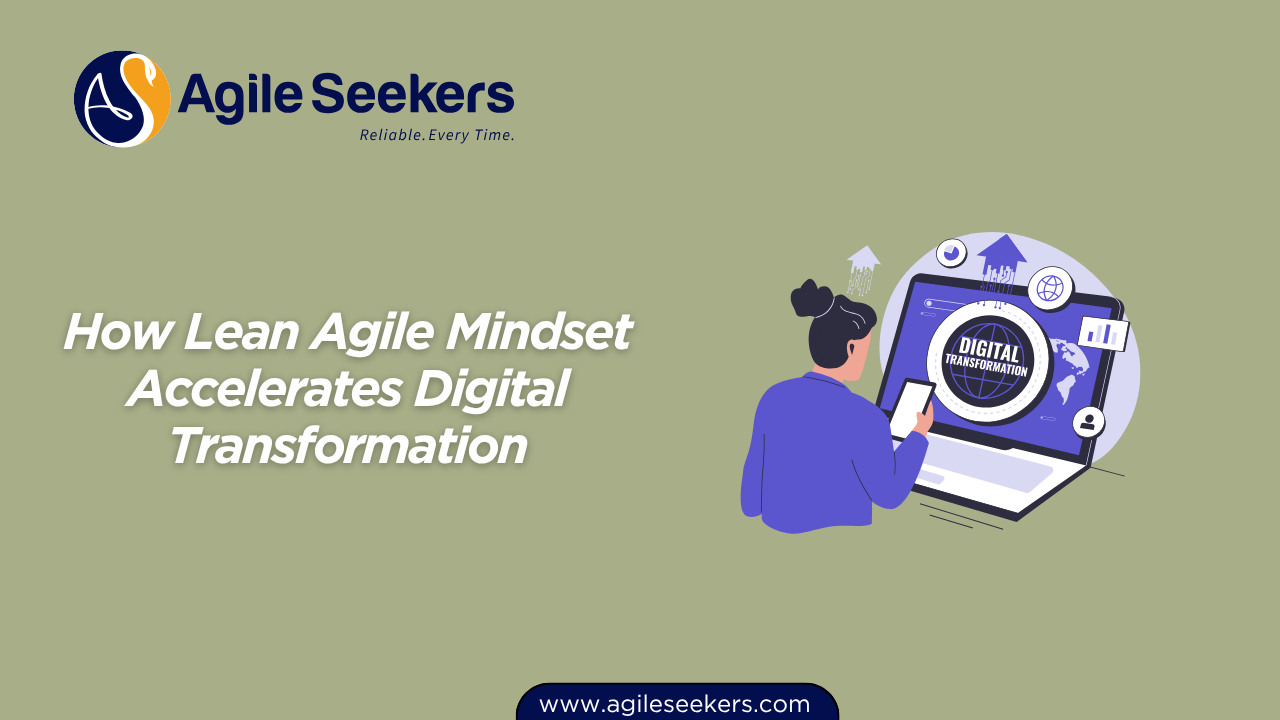How Lean Agile Mindset Accelerates Digital Transformation

Digital transformation isn’t a tech problem—it’s a mindset problem. Tools and platforms come and go, but how people think, learn, adapt, and deliver makes or breaks the entire journey. The Lean-Agile mindset is the fuel for real, lasting change. Let’s break down why.
1. What Is the Lean-Agile Mindset?
At its core, the Lean-Agile mindset is about continuous learning, rapid experimentation, and putting people at the center of every decision. It borrows principles from Lean (eliminate waste, focus on value, respect people) and Agile (adaptability, incremental delivery, collaboration).
You’ll spot this mindset in organizations where teams experiment, leaders coach more than they command, and everyone expects change—rather than dreading it.
2. Why Is Mindset the Key to Digital Transformation?
Here’s the thing: Digital transformation isn’t just about migrating to the cloud or automating manual tasks. Those are surface-level changes. The real challenge is rewiring how an organization thinks, collaborates, and delivers value.
Without the right mindset:
-
Teams cling to old habits.
-
Leaders second-guess bold moves.
-
Projects stall under bureaucracy.
The Lean-Agile mindset flips this. It encourages experimentation, rewards learning (even from failure), and accelerates delivery.
3. Five Ways Lean-Agile Mindset Accelerates Digital Transformation
a. Puts Value Delivery Front and Center
Traditional organizations love busywork—meetings, reports, endless signoffs. Lean-Agile leaders ask: What’s actually valuable to the customer? They cut the noise, optimize for flow, and use tools like Value Stream Mapping to pinpoint waste.
For those wanting a deeper dive into these leadership behaviors, the Leading SAFe Agilist Certification is a strong place to start.
b. Empowers Teams to Adapt Fast
In a digital transformation, change is constant. The Lean-Agile mindset trains teams to:
-
Welcome new information
-
Pivot without drama
-
Deliver in small, frequent increments
This adaptability is a big reason why organizations practicing Lean-Agile consistently outpace their peers. Product Owners and Managers play a critical role here—aligning teams, refining backlogs, and keeping work focused on business outcomes. If you’re in this seat or aiming for it, check out the SAFe Product Owner/Product Manager Certification.
c. Builds a Culture of Relentless Improvement
Nothing is ever “done” in digital transformation. Lean-Agile organizations run on feedback. Every sprint, release, or pilot is a chance to reflect, improve, and go again—faster, smarter.
This culture doesn’t happen by accident. It’s the result of intentional habits:
-
Regular retrospectives
-
Transparent metrics
-
Blameless post-mortems
The SAFe Scrum Master Certification dives deep into these habits and shows you how to lead them.
d. Reduces Risk Through Iterative Delivery
Trying to transform everything at once? That’s where most digital transformations stall (or collapse). Lean-Agile teams start small, deliver incrementally, and gather feedback early.
-
Less upfront planning, more learning in the real world.
-
Stakeholders see real progress sooner.
-
Problems get flagged before they become disasters.
For those ready to coach teams at a higher level, SAFe Advanced Scrum Master Certification Training adds another layer of practical tools.
e. Aligns Strategy with Execution
One of the biggest headaches in digital transformation: strategic intent gets lost as it moves down the org chart. Lean-Agile frameworks close this gap. Tools like the Agile Release Train (ART) align teams with business objectives, using transparency and data—not just hierarchy.
Release Train Engineers (RTEs) orchestrate these trains, keeping everyone focused on delivering value together. If you’re looking at transformation from an enterprise lens, the SAFe Release Train Engineer Certification Training covers exactly how to do this.
4. How This Looks on the Ground
Let’s get real. What does a Lean-Agile digital transformation look like in practice?
-
Teams own delivery: Engineers, designers, and product folks work side by side, not in silos. They prioritize together and ship together.
-
Leaders ask questions, not just give answers: The best leaders are curious. They help teams solve problems, not dictate solutions.
-
Learning is constant: Pilot, review, pivot, repeat. Every experiment is a data point.
-
Priorities are visible and change as needed: There’s no secret roadmap buried in a PowerPoint deck.
This shift doesn’t happen overnight. It requires new roles, fresh thinking, and (sometimes) uncomfortable conversations. But the payoff—faster innovation, higher engagement, and better results—is worth it.
5. Common Pitfalls (and How to Avoid Them)
Mistake #1: Treating Mindset as a Slogan
Putting Lean-Agile values on a poster doesn’t move the needle. You have to change habits, incentives, and day-to-day behaviors.
Mistake #2: Top-Down Mandates Without Buy-In
If only executives talk “Agile” but teams don’t buy in, nothing changes. Real transformation needs grassroots ownership, clear coaching, and a willingness to experiment.
Mistake #3: Overengineering the Process
Some orgs obsess over tools and frameworks, forgetting the heart of Lean-Agile: People, value, and learning. Keep it simple. Focus on outcomes.
6. The Payoff: Why Lean-Agile Wins at Digital Transformation
-
Faster Time-to-Market: Less waiting, more delivering.
-
Happier Teams: People are trusted to do great work and improve as they go.
-
Greater Customer Value: Feedback loops keep solutions relevant and sharp.
-
Lower Risk: Problems surface early and are tackled head-on.
For more on scaling these wins, you might want to look at this external guide from McKinsey on digital transformation.
7. Where to Go from Here
If your digital transformation feels stuck, stop chasing the next shiny tool. Focus on building a Lean-Agile mindset at every level. Get leaders trained, empower teams to experiment, and keep the customer at the center.
Here are a few next steps:
-
Start with a self-assessment: Where do you see old habits slowing things down?
-
Invest in role-based learning: Leading SAFe Agilist Certification for strategy, SAFe Product Owner/Product Manager Certification for team alignment, SAFe Scrum Master Certification for continuous improvement, and so on.
-
Set up feedback loops: Keep learning, keep iterating.
Want to see real transformation? Make mindset your priority.
Also read - Making Decisions with SAFe Principles in Mind
Also see - Empowering Teams through Decentralized Decision Making in SAFe




















